 |
| January 30, 2024 | Volume 20 Issue 04 |
Designfax weekly eMagazine
Archives
Partners
Manufacturing Center
Product Spotlight
Modern Applications News
Metalworking Ideas For
Today's Job Shops
Tooling and Production
Strategies for large
metalworking plants
After 3 years and 72 fights, NASA's Ingenuity Mars helicopter mission ends
Built with many off-the-shelf components, such as smartphone processors and cameras, NASA's experimental Mars Ingenuity Helicopter was designed as a technology demonstration that would fly no more than five times. The helicopter was intended to prove powered, controlled flight on another planet was possible.
After landing attached to the belly of NASA's Mars Perseverance rover (including surviving the "7 minutes of terror" maneuver that included riding on a parachuting sky crane to finally land on the surface of Mars), Ingenuity far exceeded expectations and was transitioned into being a long-term operations demonstration. The copter is 19.3 in. tall, has a tissue-box-size fuselage, weighs 4 lb, and sports two 4-ft-wide rotor blades.
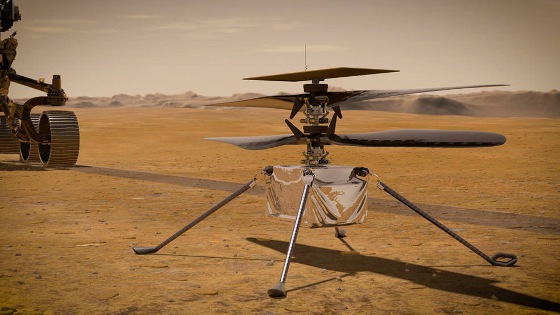
In this illustration, NASA's Ingenuity Mars Helicopter stands on the Red Planet's surface as NASA's Perseverance rover (partially visible on the left) rolls away. [Credits: NASA/JPL-Caltech]
NASA's history-making Ingenuity Mars Helicopter has ended its mission at the Red Planet after surpassing expectations and making dozens more flights than planned. While the helicopter remains upright and in communication with ground controllers, imagery of its Jan. 18 flight sent to Earth last week indicates one or more of its rotor blades sustained damage during landing, and it is no longer capable of flight.
Originally designed as a technology demonstration to perform up to five experimental test flights over 30 days, the first aircraft on another world operated from the Martian surface for almost three years, performed 72 flights, and flew more than 14 times farther than planned while logging more than two hours of total flight time.
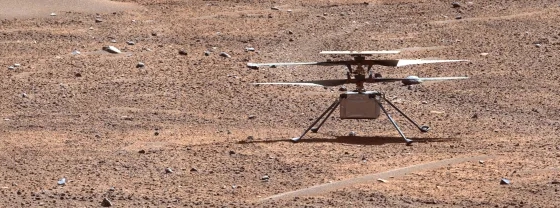
This enhanced color view of NASA's Ingenuity Mars Helicopter was generated using data collected by the Mastcam-Z instrument aboard the agency's Perseverance Mars rover on Aug. 2, 2023, the 871st Martian day, or sol, of the mission. The image was taken a day before the rotorcraft's 54th flight. [Credit: NASA]
"The historic journey of Ingenuity, the first aircraft on another planet, has come to end," said NASA Administrator Bill Nelson. "That remarkable helicopter flew higher and farther than we ever imagined and helped NASA do what we do best -- make the impossible, possible. Through missions like Ingenuity, NASA is paving the way for future flight in our solar system and smarter, safer human exploration to Mars and beyond."
Ingenuity landed on Mars Feb. 18, 2021, attached to the belly of NASA's Perseverance rover, and it first lifted off the Martian surface on April 19, 2021, proving that powered, controlled flight on Mars was possible. After notching another four flights, it embarked on a new mission as an operations demonstration, serving as an aerial scout for Perseverance scientists and rover drivers. It made many short flights.
In 2023, the helicopter executed two successful flight tests that further expanded the team's knowledge of its aerodynamic limits.
Ingenuity's team planned for the helicopter to make a short vertical flight on Jan. 18, 2024, to determine its location after executing an emergency landing on its previous flight. Data shows that, as planned, the helicopter achieved a maximum altitude of 40 ft and hovered for 4.5 sec before starting its descent at a velocity of 3.3 ft/sec.
However, about 3 ft above the surface, Ingenuity lost contact with the rover, which serves as a communications relay for the rotorcraft. The following day, communications were reestablished and more information about the flight was relayed to ground controllers at NASA JPL. Imagery revealing damage to the rotor blade arrived several days later. The cause of the communications dropout and the helicopter's orientation at time of touchdown are still being investigated.
Triumphs and challenges
Over an extended mission that lasted for almost 1,000 Martian days, more than 33 times longer than originally planned, Ingenuity was upgraded with the ability to autonomously choose landing sites in treacherous terrain, dealt with a dead sensor, cleaned itself after dust storms, operated from 48 different airfields, performed three emergency landings, and survived a frigid Martian winter.
Designed to operate in spring, Ingenuity was unable to power its heaters throughout the night during the coldest parts of winter, resulting in the flight computer periodically freezing and resetting. These power "brownouts" required the team to redesign Ingenuity's winter operations in order to keep flying.
With flight operations now concluded, the Ingenuity team will perform final tests on helicopter systems and download the remaining imagery and data in Ingenuity's onboard memory. The Perseverance rover is currently too far away to attempt to image the helicopter at its final airfield.
"It's humbling Ingenuity not only carries onboard a swatch from the original Wright Flyer, but also this helicopter followed in its footsteps and proved flight is possible on another world," said Ingenuity's project manager, Teddy Tzanetos of NASA JPL. "The Mars helicopter would have never flown once, much less 72 times, if it were not for the passion and dedication of the Ingenuity and Perseverance teams. History's first Mars helicopter will leave behind an indelible mark on the future of space exploration and will inspire fleets of aircraft on Mars -- and other worlds -- for decades to come."
Highlights
According to NASA, The many highlights of Ingenuity's historic and successful activities on Mars include:
- The first aircraft to achieve powered, controlled flight on another planet, a feat that's been called a "Wright Brothers moment."
- Completing 128.8 flying minutes, covering 10.5 miles (17.0 km), and reaching altitudes as high as 78.7 ft (24.0 m).
- Successfully flying in the extremely thin Martian atmosphere.
- Previewing areas of Mars of possible interest for the Perseverance rover to explore.
- Paving the way for future aerial explorers at Mars and, potentially, other space destinations.
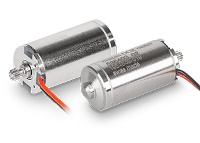
maxon's modified model DCX 10S motor is used for control of the Mars Helicopter swashplate, adjusting the inclination of the rotor blades to control the vehicle. [Picture: ©maxon motor]
Designfax sidebar: What motors drive the Mars Ingenuity helicopter?
NASA's Mars Ingenuity helicopter weighs about 4 lb on Earth and has a fuselage about the size of a tissue box. It made 72 historic, short flights on the Red Planet overall, but did you ever wonder what's inside?
What motors drive its two 4-ft-wide carbon fiber counter-rotating blades? Who makes them, and how many does it take to power flight?
They are motors from maxon (made in Switzerland). maxon's drives have a long, successful history in space applications, including in the Perseverance rover that carried the Ingenuity helicopter to Mars and landed on the planet on February 18, 2021.

Taken by the Perseverance rover, this image shows the Ingenuity helicopter during its first flight on Mars.
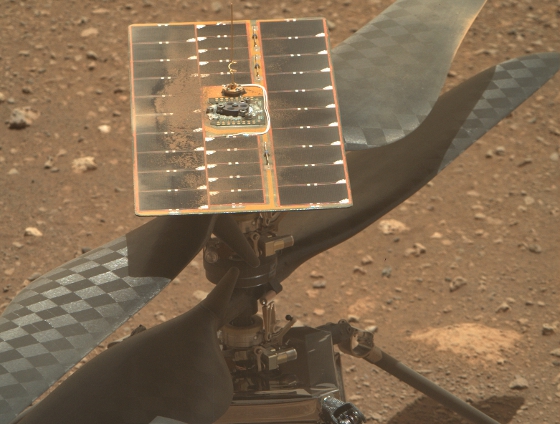
Close-up view of some of the maxon DCX motors on Ingenuity on Mars.
The Ingenuity helicopter is equipped with six brushed DC motors that were specifically modified for this challenge. The maxon DCX series of drives controlled the pitch of the rotor blades and the direction of flight for the helicopter. Each customized DCX 10S motor weighs 7.1 g (without cabling) and has a diameter of 10 mm.
Ingenuity's lightweight design was a prerequisite for successful flight on the Red Planet, where there is hardly any atmosphere, comparable to conditions at an altitude of 30 km on Earth. Engineers at maxon worked closely with AeroVironment, the company that NASA's Jet Propulsion Laboratory contracted to design and build the helicopter's propulsion system.
VIDEO: Second flight a success for NASA's Ingenuity Mars Helicopter on April 22, 2021.
"The biggest challenge in developing the motors was the extreme weight requirement," said Aiko Stenzel, design engineer at maxon. "Every tenth of a gram had to be saved to make the helicopter fly. What's great is that despite the weight savings, we found a drive solution that has enough power to adjust the rotor blades -- and this in the face of high vibrations and temperature fluctuations."
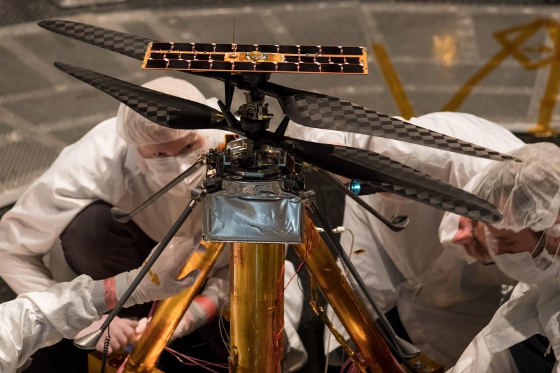
Bigger than you thought? Members of the NASA Mars Helicopter team inspect the flight model (the actual vehicle that went to the Red Planet) inside the Space Simulator, a 25-ft-wide vacuum chamber at NASA's Jet Propulsion Lab in Pasadena, CA, on Feb. 1, 2019. [Credits: NASA/JPL-Caltech]
A standard, off-the-shelf maxon DCX 10S motor weighs 6.3 g, which is under .25 oz. It has a max speed rating of 14,300 rpm. The maxon description for this motor says, "Like all motors in the DCX series, this brushed DC motor excels through high power density and low vibration. The DCX 10S exceeds the 1-mNm threshold during continuous use. With its mechanical output power of up to 1.4 W with a 10-mm diameter, it is a real powerhouse."
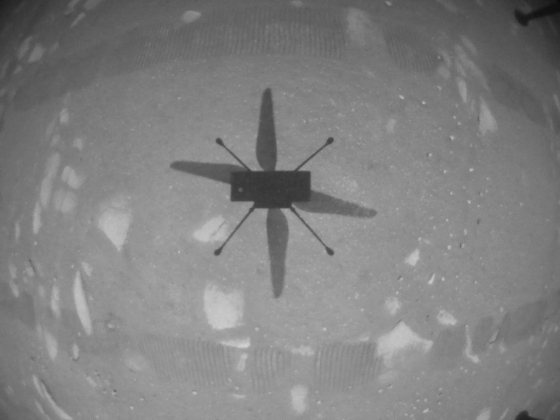
Ingenuity's camera photographed the ground and its own shadow during its maiden flight on Mars on April 19, 2021.
The standard variants of the DCX motors are available for everyone and can be configured online according to the individual customer specifications at shop.maxongroup.us.
Learn more about the Ingenuity mission and read the flight log at https://mars.nasa.gov/technology/helicopter/.
Sources: NASA, JPL, maxon
Published January 2024
Rate this article
View our terms of use and privacy policy
